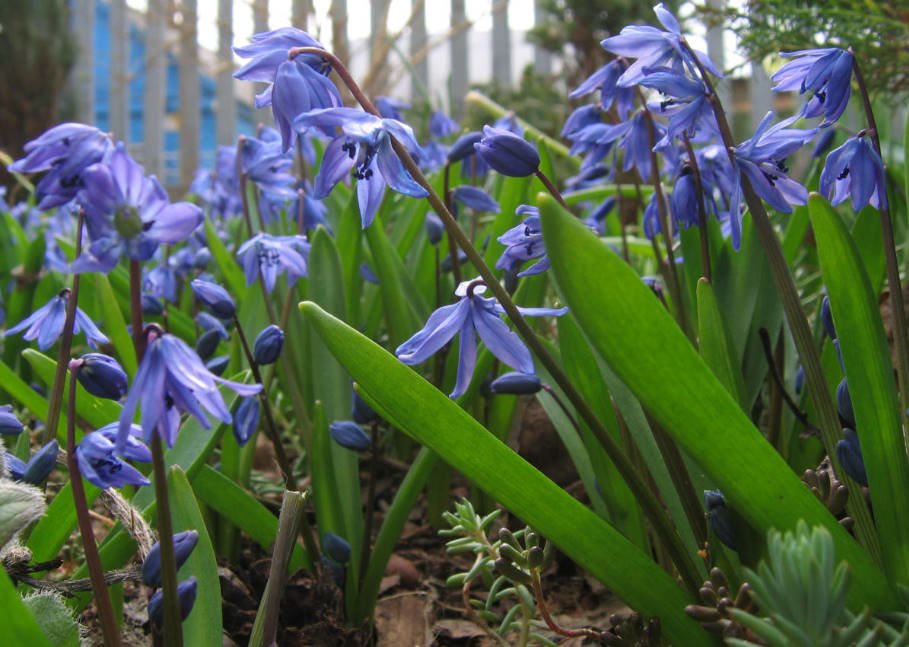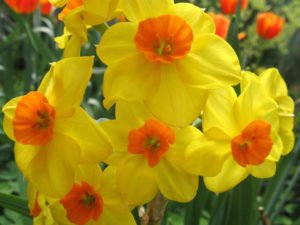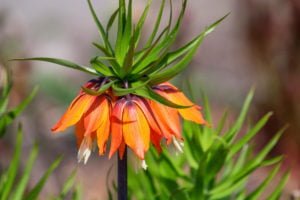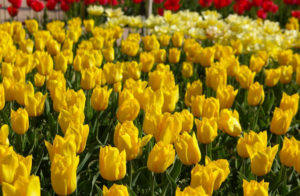I had a very happy childhood, filled with the love of my parents. Maybe that’s why it emerges in memory with bright colors. And always in these memories-an abundance of flowers, and always – spring with blue Scilla and smelling honey.
With age, becoming a professional biologist, I realized that the world of Scilla from the family Hyacinthaceae or Liliaceae is large and diverse.
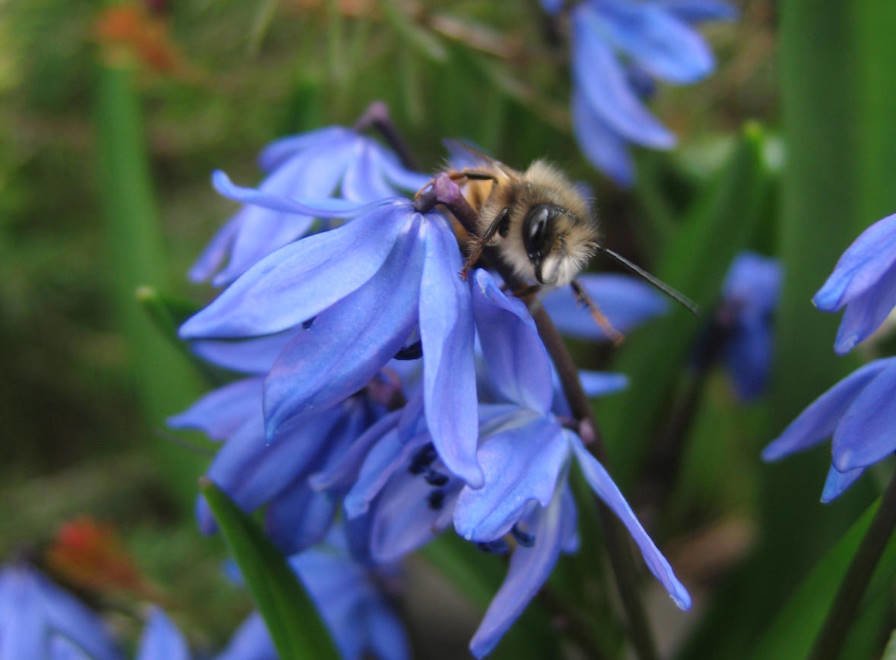
Scilla siberian and the bee
It is represented not only by the most common Scilla siberian, but also by other species, forms, varieties, which will be discussed today. But first (for the intrigue) I will give some figures and facts.
Scilla Options:
- height from 5 to 120 cm;
- number of leaves from 2 and more;
- the flowers are white, blue, blue, purple, pink, plus different shades;
- there’s not only spring but also summer blooming varieties.
Popular spring species and varieties
It is quite winter-hardy unpretentious Scilla: their winter temperature minimum is -15°C.
Scilla bithynica
Scilla bithynica is a small bulbous perennial with a height of 10-15 cm and 8 cm wide; native to Bulgaria, Turkey.
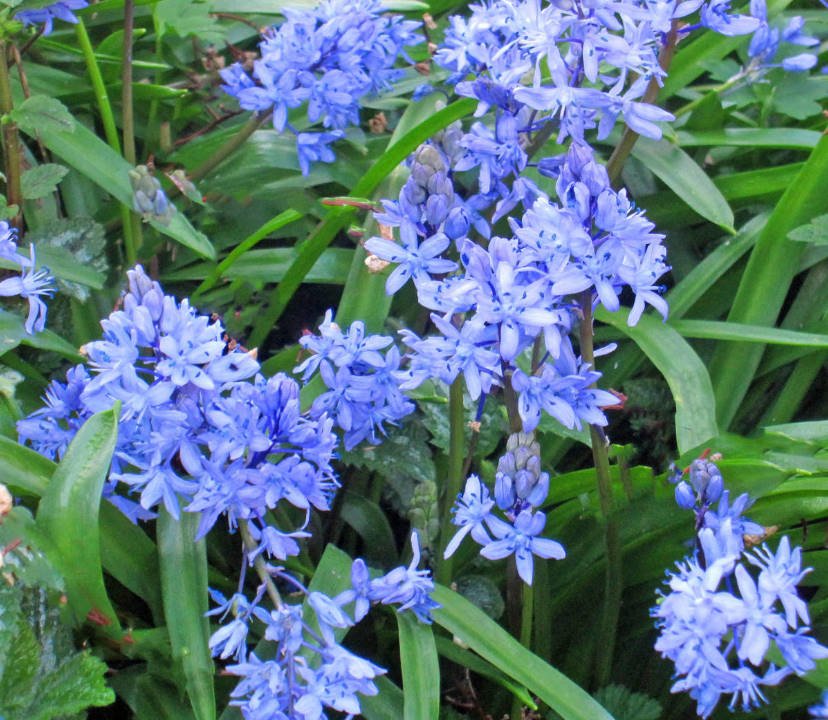
Scilla bithynica
Basal leaves (ie leaves at the base of the stem, in this case, the peduncle) 3-5 pieces, 20 cm long, develop in the spring. The flowers are blue, stellate, 2 cm in diameter, collected in a brush of 6-12 pieces; bloom in the spring.
Scilla hohenackeri
Scilla hohenackeri is an onion perennial 10-20 cm high and 5 cm wide; native to Azerbaijan, Iran. Very similar to Scilla cilicica.

Scilla hohenackeri close-up
Basal leaves 3-5, they are linear, with a length of 10-25 cm Flowers are pale blue, 1.5 cm in diameter, in racemes 4-12 pieces; bloom in the spring.
Scilla bifolia
Scilla bifolia is a small bulbous perennial 8-15 cm high and 5 cm wide; native to Central, southern Europe, Turkey.
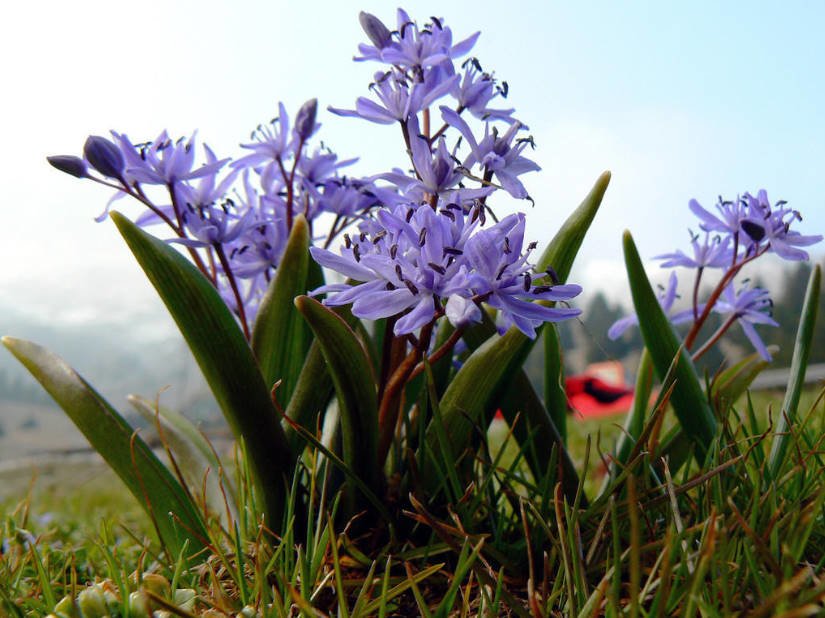
Scilla bifolia
Basal leaves 2, broadly linear, with a length of 5-20 cm Flowers from blue to purple-blue, star-shaped, with a diameter of 2.5-4 cm, often grouped in one-sided racemes up to 10 pieces; bloom in early spring.
Scilla cilicica
Scilla cilicica is an onion perennial 15-35 cm high and 8 cm wide; native to Turkey.
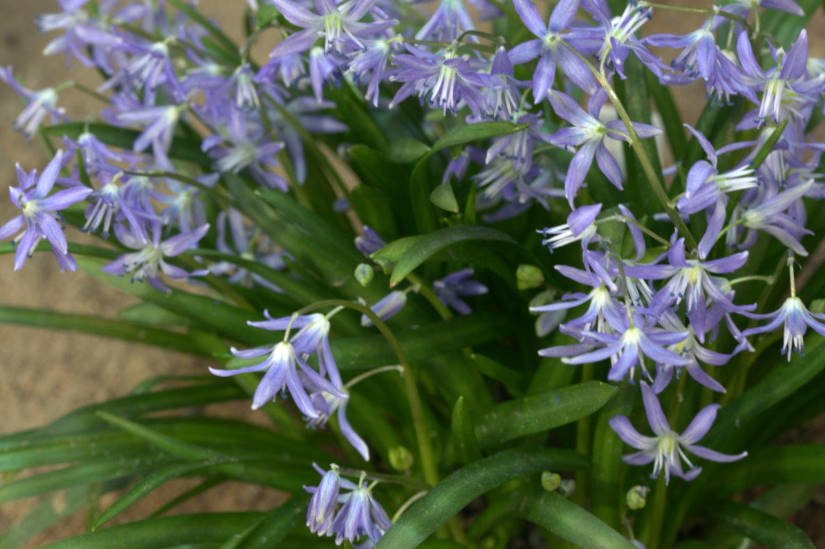
Scilla cilicica
Basal leaves 3-4, they are wide, 15-25 cm long, appear in the autumn. Flowers lavender-blue, 2-3 cm in diameter, collected in a brush of 5-15; bloom in the spring. Temperature winter minimum -10°C.
Scilla liliohyacinthus
Scilla liliohyacinthus is a small bulbous perennial plant 15-25 cm high and 7 cm wide; native to the South-West of France, Spain.
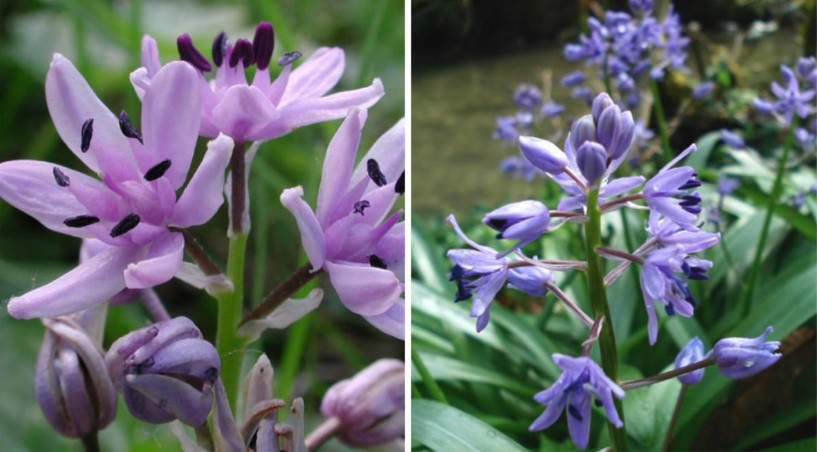
Scilla liliohyacinthus
Basal leaves 6-10, they are shiny, 15-30 cm long. the Flowers are lilac-blue, rarely-white, 1.5 cm in diameter, collected in brushes of 5-20; bloom in late spring.
Scilla siberica
Scilla siberica-the most common perennial bulb height of 10-20 cm and a width of 5 cm; originally from Russia, Ukraine, Georgia, Azerbaijan, Northern Iran.
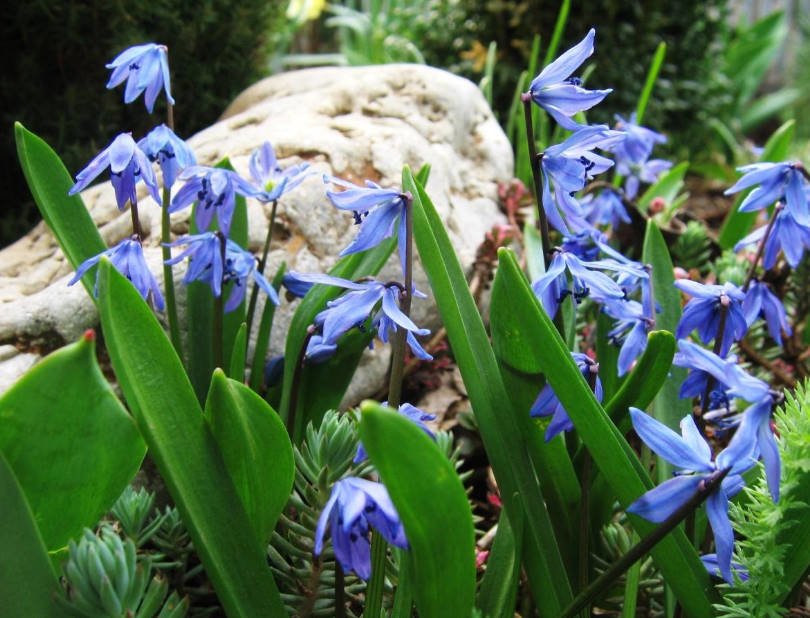
Scilla siberica
Basal leaves 2-4, broadly linear, 10-15 cm long the Flowers are Cup-shaped, drooping, bright blue, 1.5 cm in diameter, collected at 4-5; bloom in the spring. The flower stalks are gradually longer.
Decorative varieties:
- ‘Alba – – white flowers;
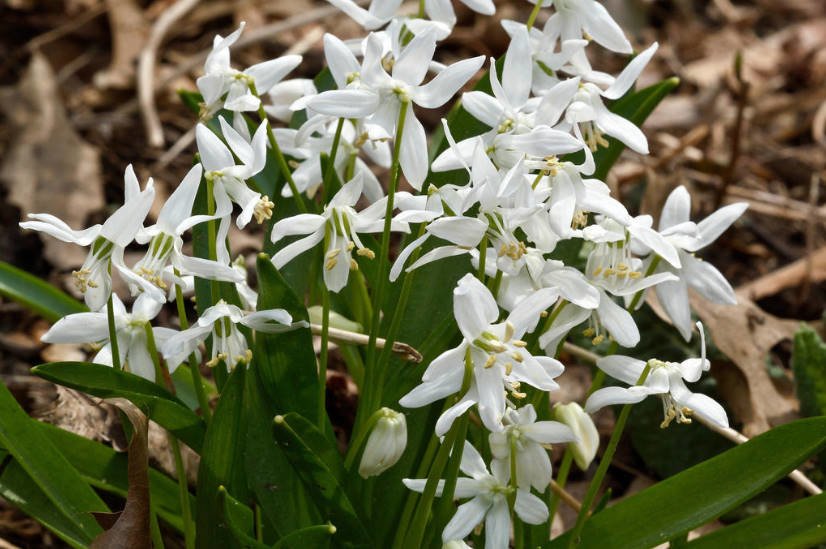
Scilla siberica variety ‘Alba’
- ‘Atrocoerulea’, syn. ‘Spring Beauty’ -up to 20 cm, the flowers are dark blue.

Scilla siberica variety ‘Spring Beauty’
Some Scilla on sale may be presented under the guise of other plants.
Broad-leaved, late-flowering and rare species and varieties
They are also winter-hardy: their winter temperature minimum is -15°C.
Scilla hispanica
In the trade directories you can find her under the name of hyacinthoides Spanish.
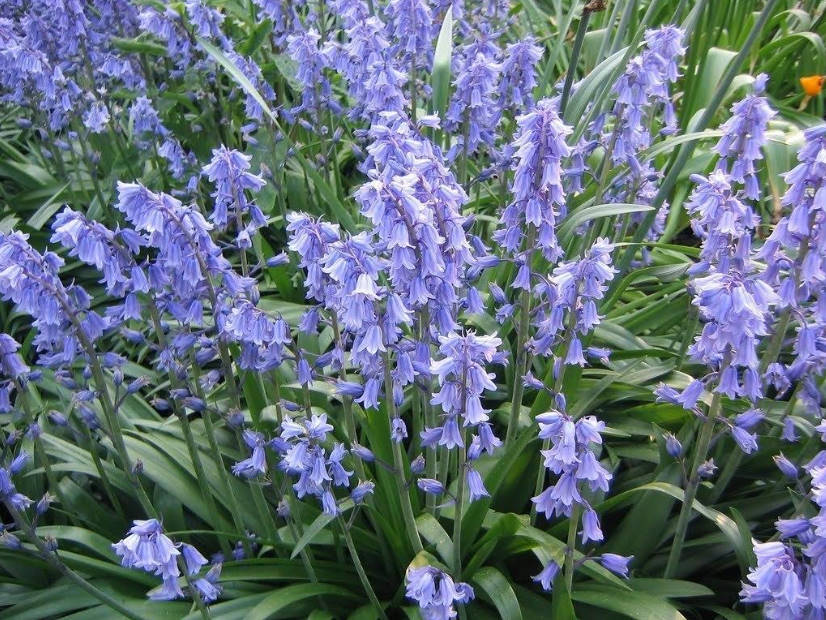
Scilla hispanica
Scilla hispanica, syn. Hyacinthoides hispanica, Endymoin hispanicus is a sturdy bulbous perennial with a height of 40 cm and a width of 10 cm; growing rapidly. He comes from Portugal, Spain, North Africa. Leaves is shiny, dark green, length 20-60 cm Flowers campanulate, blue, 2 cm in diameter, in racemes to 15; blooming in the spring.
Decorative varieties:
- ‘Excelsior – – height 50-55 cm, purple-blue flowers, with light blue stripes;

Scilla hispanica variety ‘Excelsior’
- ‘La Grandesse – – white flowers, 2.5 cm in diameter;
- ‘Rosabella’ -purple-pink flowers, in brushes.

Scilla hispanica variety ‘La Grandesse’ and Scilla hispanica variety ‘Rosabella’
Interesting? Useful? Then continue our review.
Scilla Peruvian
Scilla Peruvian is an almost evergreen bulbous perennial 15-30 cm high and 10 cm wide.

Scilla Peruvian
He comes from Portugal, Spain, Italy, North Africa. Leaves: from 5 to 15 pieces, lanceolate, 40-60 cm long, young develop in autumn – to replace the old. The flowers are dark purple, blue, white, 1.5 cm in diameter, collected in conical brushes of 50-100 pieces.; bloom in summer.
- Decorative shape: f. alba-white flowers, collected in capitate inflorescences.
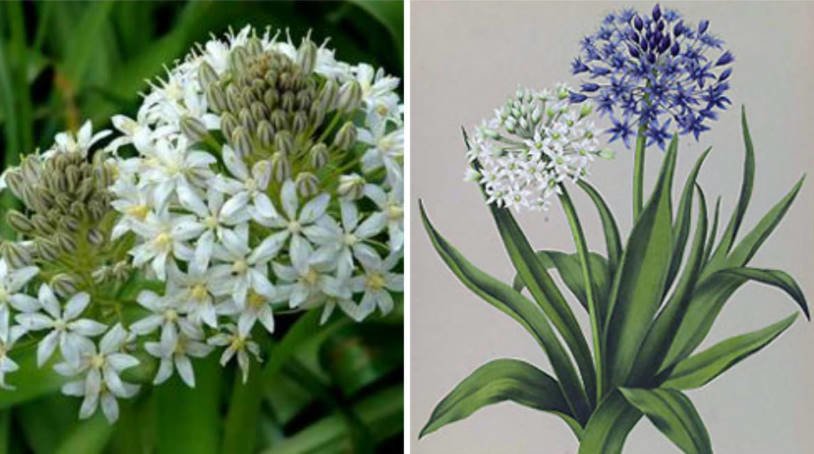
Scilla Peruvian alba form and drawing with its image
And now-Scilla for lovers of dwarf plants.
Scilla mischtschenkoana, syn. S. tubergeniana
Scilla mischtschenkoana, syn. S. tubergeniana – dwarf bulbous perennial with a height of 10-15 cm and a width of 5 cm.
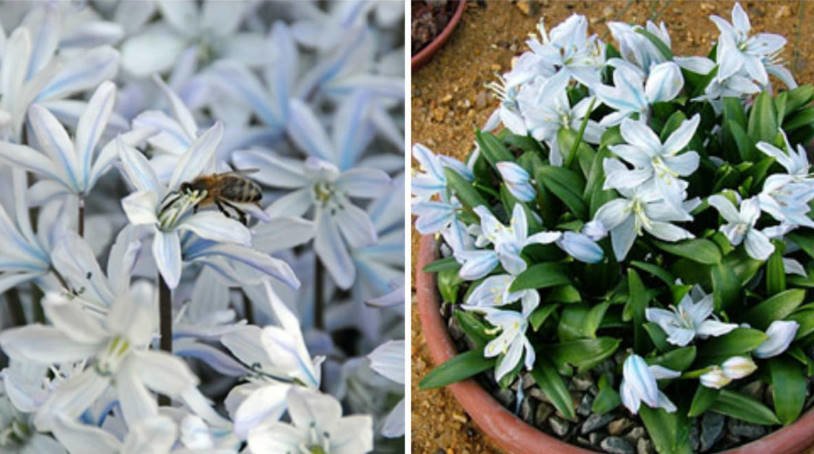
Scilla mischtschenkoana
He comes from Georgia, Armenia, Azerbaijan, Iran. Basal leaves 3-5, they are linear, with a length of 4-10 cm Flowers are blue with darker stripes, 2 cm in diameter, in racemes of 2 or 6; bloom in the spring.
Rare exotic Scilla for the South
To be precise, these Scilla are suitable for cultivation on the more southern edges, as their temperature minimum 0°C.
Scilla natalensis
Scilla natalensis is an onion perennial 30-120 cm high and 8 cm wide.
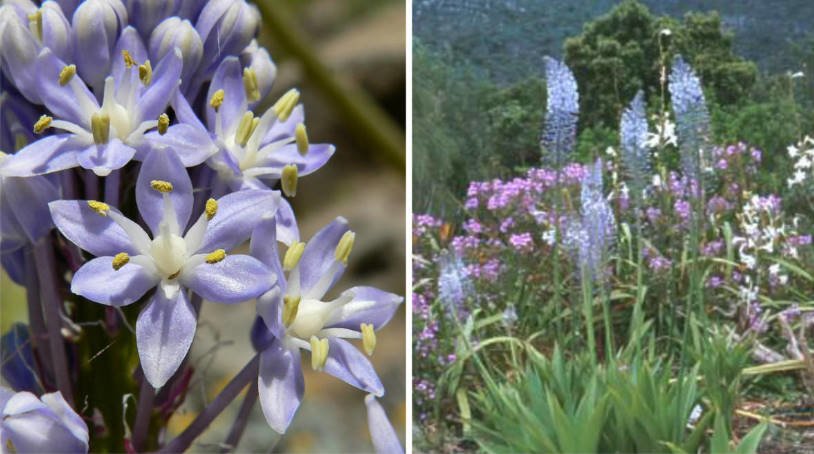
Scilla natalensis flowers close-up and General view of Scilla natalensis
He comes from South Africa. Leaves 4-8, they are linear, up to 20 cm (when they appear during flowering), later – up to 30-60 cm flowers violet-blue, blue, pink, 1.5 cm in diameter, collected in inflorescences-brush up to 100; bloom in the summer.
What do unpretentious Scilla like
- semi-shaded areas (in open areas in the first years of planting Scilla mulch peat, humus, dry leaves; but immediately after the snow thaw shelter removed);
- soil: loose, drained, fertile, moist, non-acid;
- in one place grow for years, but to preserve the decorative transplant carried out in 3-4 years;
- feeding with complex mineral fertilizer on snow (or immediately after the descent) and during flowering;
- loosening;
- watering during dry periods.
What does not love the Scilla
- waterlogging and soil compaction;
- neighborhood weeds.
Features of Scilla transplant
- After yellowing leaves, digging up bulbs.
- We clear of the earth, dry roots.
- Lay in craft packages.
- Store in a ventilated room.
- We plant in late September-early October at a depth of 5-10 cm (depending on the size of the bulb), adhering to a distance of 4-8 cm
Important! Scilla can be transplanted and flowered in the form.
Features of Scilla reproduction
Some species (such as Scilla siberica) give self-seeding, but this should not be allowed, so it is necessary to remove the seed boxes in a timely manner.
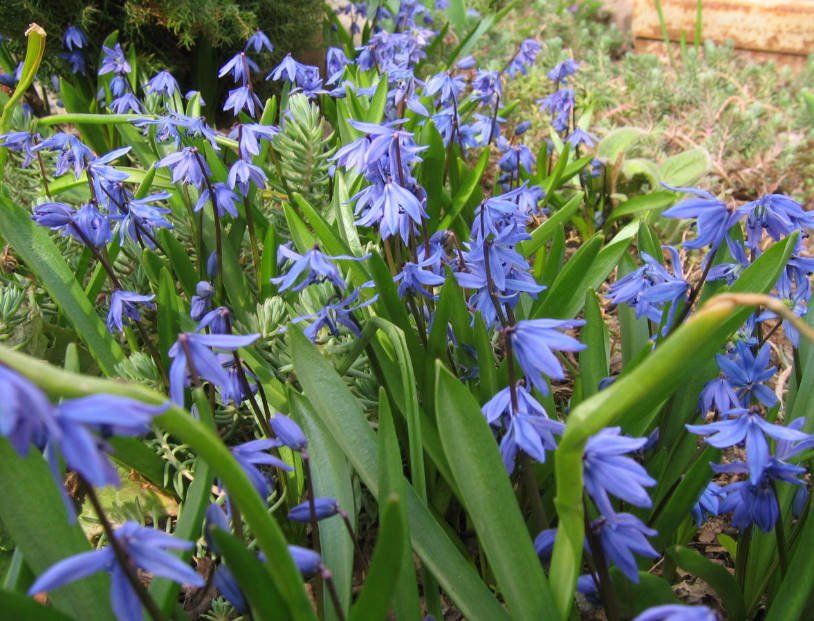
Scilla siberica
Mainly propagated by bulbils subsidiaries (the children).
Important! Seedlings bloom for 3-4 years.
Scilla in the country
They are excellent under trees and shrubs, in mixed borders, rockeries, low garden vases.

Scilla siberica together with Erica grassy
Spring-flowering Scilla look harmonious with Galanthus, Eric, Crocus, blooming at the same time. It is necessary to plant other perennials nearby, which can cover them after flowering.
How to kick Scilla out
Scilla is good in touching romantic bouquets.

Scilla in bouquet
They can be expelled to any term for what it is necessary:
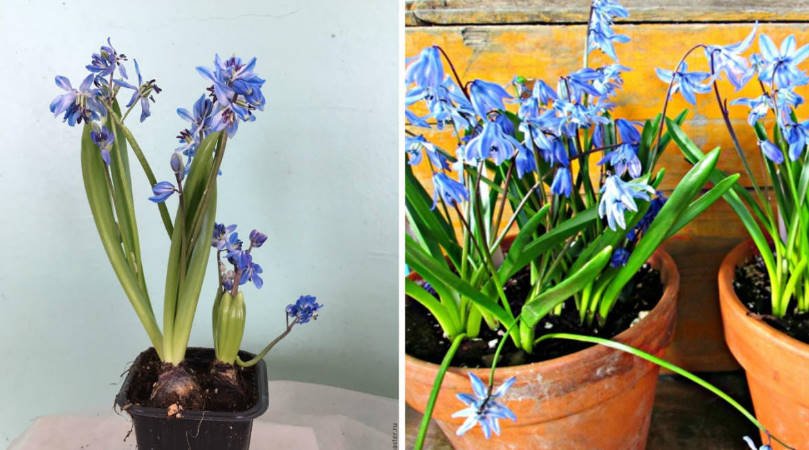
Scilla siberica in distillation
- In October, take a pot (preferably a short, but wide) on the bottom lay a drainage of broken bricks. Fill the container with soil substrate consisting of turf, sand and peat taken in equal parts.
- To plant the largest healthy bulbs left during the transplant, to a depth of 1-2 cm, adhering to a distance of 2 cm between them, pour.
- Put in a dark room with a low positive temperature +3..+5°C.
- For 15-20 days before the desired period of flowering pot with Scilla move to a dark place (you can cover with thick paper) with a temperature of +12…+15°C.
- After 5-7 days, remove the paper, put Scilla on the light and gradually increase the temperature to 18…+20°C.
And finally, the traditional questions: Scilla grow whether you are in the country? What compositions are they included in?
